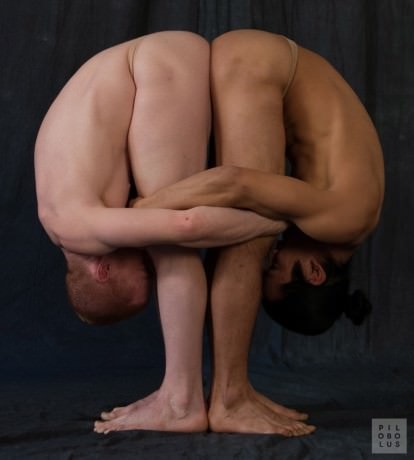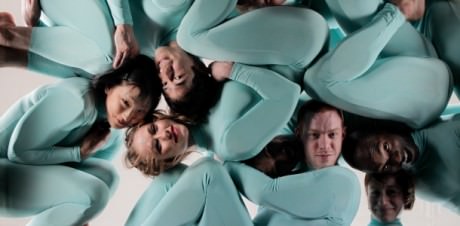Founded in 1971 as a dance collective by Dartmouth College students, this company still wears its revolutionary stripes on its sleeves. Pilobolus was named after a barnyard fungus that propels its spores with extraordinary speed, accuracy and strength. Pilobolus has many fans that have followed it through the decades. The dance collective is known for its signature style, eerily beautiful formations and movements, witty and contortionist gymnastics, and endlessly inventive works.

Because of the excellence of its six dancers, Pilobolus could dip into its repertoire and randomly select a sample of pieces that would entertain almost any audience. The performance at Strathmore included recent and early works as well as short films between each dance. Though the dancers remain constant, the choreographers with which they work are a roster of some of the finest America has to offer.
Under the artistic direction of Robby Barnett and Michael Tracy, Pilobous presented five dance pieces — three highlighting eerily beautiful formations and movements, one comical piece and one that incorporated the use of props and had segments of what appeared to be improvisation but was in fact, another case of innovative choreography.
Automation (2012), commissioned by the American Dance Festival and performed by all six dancers, segued from a picture of automatons, with staccato movements led by the dancers’ white gloves to blending into one flowing and pulsing organism. Each transition was marked by the removal of a piece of clothing, starting with the gloves and moving through removal of shirts and other excess pieces. As with the beginning of any Pilobolus performance, I was struck once again by the strength, gracefulness, and agility of each dancer.
The idea of the dancers as one organic body was emphasized in Korokoro (2011), also commissioned by the American Dance Festival. Costumes, designed by Liz Prince, consisted of thongs for all and very abbreviated tops for the two female dancers. The exposure of most of the dancer’s body allowed for appreciation of their musculature at work. Like the latter parts of Automation, Korokoro showcased the troupe as one organism, melding, breaking apart, then coming back together again. One particularly interesting element was the constant shifting of weight bearing between pairs of dancers.
Ocellus (1972), performed by the four male dancers still in thongs, introduced the effect that sound could have on the dancers’ movements. The music, written by Moses Pendleton and Jonathan Wolken, was the driver of this complex piece.
Walklyndon, was a delightful, comical presentation that still called on the four male dancers strength, coordination and timing. Outfitted in yellow body suits and different colored basketball shorts, the dancers walked back and forth across the width of the stage, with each meeting of two dancers involving some comic element.
Rushes (2007), also commissioned by the American Dance Festival with support from other funders, was the closest to a theatrical production with costuming, by Avshalom Pollak and Inbal Pinto, film animation by Oeter Sluszka, and lighting by Yoann Tivoli. Each dancer developed a distinct character that became richer over time. Sound was an important component of Rushes, beginning first with calliope-type music, the sound of swarms of mosquitoes, and a constant undertone of water rushing. Important props included a suitcase from which a bed sheet was pulled to form a background for one person’s dreams, a hanging lightbulb turned on and off, and a set of chairs which were, at one point, moved as if in a can-can line. The lighting helped draw the audience’s focus to the important aspects of the unfolding story and was delightful in the projection of the sleeper’s dreams. At its core, and despite its jolly moments, however, the piece is about unmet dreams.
Each dance was preceded by a short film, some of which seemed to be tied to the motif of the following dance and others that seemed referential to a different dance. Pilobolus introduced their self-concept through the short film Pilobolus is a Fungus at the beginning of the performance and set up the audience for the delights they were about to observe.
Although Pilobolus has been in existence since 1971, its dancers hail from all periods of its growth, with the newest being Mike Tyus, for whom this is first season, and Benjamin Coalter who joined in 2012. Eriko Jimbo, Jordan Kriston, Nile Russell, and Matt Del Rosario have been with the troupe for at least 3 years. All is not new at Pilobolus: Choreographer Moses Pendleton co-founded the collective in 1971; costume designers Kitty Daly has worked with the collective since 1971, and; Lighting Designer Neil Peter Jampolis has created more than 50 new works for the company after joining in 1975.

The work of the six dancers is supported by an army of choreographers, artistic directors, producers, musicians, and sound, set, lighting and costume designers. This reflects Pilobolus’ emphasis on working with collaborators varying from Google, the Wharton Business School and the MIT Distributed Robotics Laboratory to Penn and Teller and the band OK Go. Executive Directors Itamar Kubovy and Lily Binns help the collective’s activities continue to grow.
Each year, Pilobolus offers new and exciting works making their every visit to Washington a reason to return to see them in action.
Running time: Two hours and thirty minutes, with one intermission.
Pilobolus Dance Company performed one night only at the Music Center at Strathmore – 5301 Tuckerman Lane, in North Bethesda, MD. Check their calendar for future events.
LINK
Pilobolus website.




